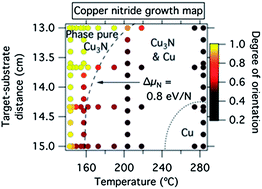Thin film synthesis and properties of copper nitride, a metastable semiconductor†
Abstract
Copper nitride (Cu3N) thin films were grown by reactive sputtering using a high-throughput combinatorial approach with orthogonal gradients of substrate temperature and target–substrate distance. This technique enables high-throughput modulation of the anion activity, and is broadly applicable to the combinatorial synthesis of other materials. Stable, phase pure Cu3N thin films were grown on glass substrates at temperatures between 150 and 200 °C, depending on the target–substrate distance. These 00L oriented thin films have 10−3 S cm−1 conductivity and 1.5 eV optical absorption onset, making Cu3N interesting for future studies in the context of solar energy conversion applications. The analysis of the synthetic results provides insights into the thermodynamic origins of the growth of metastable Cu3N, and sets a nitrogen chemical potential of +1 eV per atom as a lower limit of the anion activity that can be achieved in non-equilibrium thin film growth of metastable materials. The first step towards testing the transferability of this result to other materials was made by reactive sputtering of tin, antimony, and bismuth in nitrogen.


 Please wait while we load your content...
Please wait while we load your content...